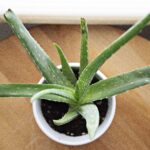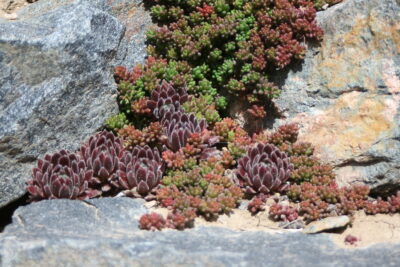
Learn How to Successfully Propagate Your Black Rose Succulent

Black rose succulents, also known as Aeonium arboreum 'Zwartkop', are striking plants that are popular among succulent enthusiasts. With their dark, velvety leaves and unique rosette shape, these succulents add a touch of elegance to any garden or indoor space. However, propagating black rose succulents can be a bit challenging for beginners. Understanding the proper techniques and conditions for propagation is essential for successfully growing new plants from cuttings.
We will explore the process of propagating black rose succulents step by step. We will discuss the best time to take cuttings, the tools and materials needed, and the proper methods for preparing and planting the cuttings. Additionally, we will provide tips for caring for the newly propagated black rose succulents to ensure their healthy growth. By following these guidelines, you will be able to expand your collection of black rose succulents and enjoy their beauty for years to come.
- Provide the succulent with well-draining soil and a suitable container
- Ensure the succulent receives adequate sunlight, but not direct, harsh sunlight
- Water the succulent sparingly, allowing the soil to dry out between waterings
- Use a rooting hormone to promote successful propagation
- Gently remove a healthy leaf or stem from the parent plant
- Allow the cutting to callous over for a few days before planting it in soil
- Keep the new cutting in a warm and humid environment to encourage root growth
- Monitor the cutting for signs of roots, such as new growth or resistance when gently tugged
- Once the cutting has established roots, gradually acclimate it to normal growing conditions
- Continue to care for the propagated succulent as you would with an established plant
- Frequently Asked Questions
Provide the succulent with well-draining soil and a suitable container
When propagating your black rose succulent, it's crucial to provide it with the right growing conditions. Start by choosing a well-draining soil mix that will prevent water from sitting around the roots, which can lead to root rot. A mix consisting of equal parts of cactus soil, perlite, and sand works well for black rose succulents.
Next, select a suitable container for your propagated succulent. It's important to choose a container with drainage holes to allow excess water to escape. A small terracotta pot or a plastic container with drainage holes are both excellent options.
Ensure the succulent receives adequate sunlight, but not direct, harsh sunlight
Propagating black rose succulents can be a rewarding and fascinating experience for any plant enthusiast. Whether you're a beginner or an experienced gardener, successfully propagating these unique succulents requires a few key considerations. One of the most important factors to bear in mind is providing the right amount of sunlight.
Black rose succulents thrive in bright, indirect sunlight. While they do require a good amount of light, it's crucial to avoid exposing them to direct, harsh sunlight. Too much direct sunlight can lead to sunburn, causing the leaves to turn brown or even black. To prevent this, it's advisable to place your black rose succulent in a spot that receives bright, filtered light, such as near a window with sheer curtains. If you're growing them outdoors, consider providing some shade during the hottest parts of the day.
 Step-by-Step Guide: How to Successfully Propagate Succulents at Home
Step-by-Step Guide: How to Successfully Propagate Succulents at HomeRemember, finding the right balance of sunlight is essential for the health and growth of your black rose succulent. Too little light can result in etiolation, where the plant stretches out and becomes leggy. On the other hand, excessive light can lead to heat stress and damage the plant's foliage. By providing adequate, indirect sunlight, you can ensure your black rose succulent thrives and maintains its distinctive dark color.
Water the succulent sparingly, allowing the soil to dry out between waterings
To successfully propagate your black rose succulent, it is important to water the plant sparingly. Overwatering can lead to root rot and other issues. Allow the soil to dry out completely between waterings to ensure proper drainage and prevent waterlogged roots.
Use a rooting hormone to promote successful propagation
When it comes to propagating your black rose succulent, using a rooting hormone can greatly increase your chances of success. Rooting hormones contain growth-promoting substances that encourage the development of new roots, helping the cutting establish itself and grow into a healthy plant.
There are different types of rooting hormones available, such as powder, gel, and liquid forms. You can easily find them at your local garden center or online. Before applying the rooting hormone, make sure to prepare your cutting properly.
Here's how to use a rooting hormone for successful propagation:
 The Cause of Tall Growth and Limited Spreading in Succulents
The Cause of Tall Growth and Limited Spreading in Succulents- Prepare the cutting: Choose a healthy stem from your black rose succulent plant. Using a clean, sharp knife or shears, cut a 4-6 inch section just below a leaf node. Remove any lower leaves, leaving only a few at the top.
- Dip in rooting hormone: Pour a small amount of rooting hormone into a separate container, making sure not to contaminate the main container. Dip the cut end of the stem into the rooting hormone, ensuring it is fully coated for maximum effectiveness.
- Plant the cutting: Fill a small pot or container with well-draining soil mix. Make a small hole in the soil using your finger or a pencil and gently place the cutting into the hole. Press the soil around the stem to ensure good contact.
- Provide proper care: After planting the cutting, place it in a warm and bright location, but away from direct sunlight. Keep the soil slightly moist, but avoid overwatering as it can lead to rot. Mist the cutting regularly to maintain humidity.
- Monitor and wait: It may take a few weeks for roots to develop. During this time, keep a close eye on the cutting to ensure it remains healthy. Once you notice new growth and roots emerging, you can gradually introduce it to more sunlight and normal watering routine.
By using a rooting hormone and following these steps, you can significantly increase your chances of successfully propagating your black rose succulent. Remember to be patient and provide the proper care needed for the cutting to establish itself and thrive as a new plant.
Gently remove a healthy leaf or stem from the parent plant
Once you have identified a healthy leaf or stem on your parent black rose succulent plant, it's time to carefully remove it for propagation. This process requires a gentle touch to ensure that the cutting remains intact and has the best chance of successfully rooting and growing into a new plant.
Begin by selecting a sharp, sterilized knife or pair of scissors to make a clean cut. It's important to avoid using tools that may introduce bacteria or other contaminants to the cutting, as this can hinder its chances of developing roots.
Next, locate a suitable spot on the parent plant where you can make your cut. Look for a mature leaf or stem that appears healthy and has no signs of damage or disease. The ideal cutting should be approximately 4-6 inches long, with at least a few nodes or leaf pairs along its length.
Important: Before proceeding, make sure to wear gloves to protect your hands from any potential thorns or prickly spikes that the black rose succulent may have.
Preparing the cutting for propagation
Once you have carefully removed the cutting from the parent plant, it is crucial to prepare it properly for propagation. This involves removing any excess leaves or stems that may hinder its ability to root and grow.
 Guide: How to Successfully Propagate an Ogre Ear Succulent
Guide: How to Successfully Propagate an Ogre Ear SucculentUsing your sterilized knife or scissors, gently trim off any leaves or stems from the lower portion of the cutting. Leave at least two or three leaf pairs or nodes at the top of the cutting, as these will be essential for new growth and root development.
After trimming, you may notice a milky sap oozing from the cut ends of the cutting. This is normal and is simply the plant's way of protecting itself. However, it is recommended to allow the cut ends to dry and callus over for a day or two before proceeding with the propagation process.
Note: It's important to be cautious when handling the cutting, as the sap of the black rose succulent can cause skin irritation or allergic reactions in some individuals.
Choosing the right propagation method
There are several methods you can choose from to propagate your black rose succulent successfully. The two most common methods include water propagation and soil propagation. Each method has its own advantages and suitability depending on your preferences and the resources available to you.
- Water propagation: This method involves placing the cutting in water, allowing it to develop roots before transferring it to soil. It is an excellent option for beginners and allows you to closely monitor root development.
- Soil propagation: This method requires planting the cutting directly into a well-draining soil mix. It mimics the natural conditions for root development and can provide quicker results.
Whichever method you choose, make sure to provide the cutting with proper care and maintenance, including appropriate lighting, temperature, and moisture levels. By following these steps and giving your black rose succulent cutting the attention it needs, you can increase your chances of successful propagation and enjoy the beauty of a new thriving plant.
Allow the cutting to callous over for a few days before planting it in soil
Before you plant your black rose succulent cutting, it is crucial to let it callous over. This process typically takes a few days and helps the cutting develop a protective layer that prevents rotting once it is planted in soil.
 Alternative Methods of Propagating Succulents: Beyond Seeds
Alternative Methods of Propagating Succulents: Beyond SeedsTo allow the cutting to callous over, you should place it in a dry and well-ventilated area. Avoid exposing it to direct sunlight, as this can cause the cutting to dry out too quickly. Instead, choose a spot that receives indirect light.
Pro tip: You can place the cutting on a paper towel or a clean, dry surface to ensure proper air circulation during the callousing process.
Keep the new cutting in a warm and humid environment to encourage root growth
Propagating black rose succulents can be a rewarding and exciting experience for any plant lover. One of the key factors for successful propagation is to create an ideal environment for root growth. By keeping the new cutting in a warm and humid space, you can provide the necessary conditions for the roots to develop and thrive.
Here are some essential tips to help you create the perfect environment for your black rose succulent cuttings:
1. Choose the right container
When selecting a container for your cuttings, ensure it has drainage holes to prevent excess moisture buildup. A small pot or tray made of plastic or ceramic works well. Make sure the container is clean and disinfected to avoid any potential diseases.
2. Use well-draining soil
Black rose succulents prefer well-draining soil to prevent root rot. A mix of cactus soil and perlite or coarse sand will provide the perfect balance of moisture retention and drainage. Avoid using regular potting soil, as it tends to retain too much water.
 Can Succulent Plants Reproduce and Become Pregnant?
Can Succulent Plants Reproduce and Become Pregnant?3. Mist the cutting regularly
Creating a humid environment around the cutting is crucial for encouraging root growth. Use a spray bottle to mist the cutting and the surrounding soil regularly. However, be cautious not to overwater as this can lead to rotting. The goal is to maintain a lightly moist environment.
4. Provide indirect sunlight
While black rose succulents need sunlight to thrive, exposing the newly propagated cuttings to direct sunlight can be harmful. Place them in an area with bright, indirect light to avoid scorching or sunburn. Gradually introduce them to more sunlight as they grow stronger and establish roots.
5. Maintain consistent temperature
Black rose succulents prefer temperatures between 70-80°F (21-27°C) during the rooting process. Avoid exposing the cuttings to extreme temperature fluctuations, as this can stress or damage the fragile roots. Keep them in a warm and stable environment.
By following these tips and providing the right environment, you can increase the chances of successful root growth for your black rose succulent cuttings. Patience and care are key, as it may take several weeks or even months for the roots to establish. Once rooted, you can enjoy watching your new plants grow and flourish!
Monitor the cutting for signs of roots, such as new growth or resistance when gently tugged
When propagating your black rose succulent, it is important to monitor the cutting for signs of roots. One way to do this is by looking for new growth. As the cutting begins to root, you may notice small buds or leaves emerging from the stem. This is a positive sign that the cutting is establishing roots and thriving.
In addition to looking for new growth, you can also test the cutting for resistance when gently tugged. As roots develop, they anchor the cutting in the soil or growing medium. If you feel resistance when lightly pulling on the stem, it indicates that the roots are growing and securing the cutting in place.
Remember to be patient during this process, as it can take several weeks for roots to develop. Keep a close eye on the cutting and provide it with the necessary care to ensure successful propagation.
 Succulent Propagation: A Guide to Time Required
Succulent Propagation: A Guide to Time RequiredOnce the cutting has established roots, gradually acclimate it to normal growing conditions
Once you have successfully propagated your black rose succulent by taking a cutting, it is important to gradually acclimate it to normal growing conditions. This step is crucial in ensuring the health and survival of your newly propagated plant.
When your cutting has established roots, it means that it is ready to transition from its delicate propagation environment to a more stable and regular growing environment. Here are some steps to follow to successfully acclimate your black rose succulent:
Step 1: Gradually Increase Light Exposure
Start by placing your propagated cutting in an area with slightly more light than it was previously exposed to. This can be done by moving it closer to a window or providing it with some filtered sunlight. Avoid placing it under direct, intense sunlight at this stage.
Step 2: Adjust Watering Routine
As your black rose succulent adapts to its new environment, you should also adjust its watering routine. Gradually reduce the frequency of watering to allow the plant to adjust and encourage the development of a strong root system. Be careful not to overwater during this transition period.
Step 3: Introduce Normal Temperature Conditions
Ensure that the temperature around your black rose succulent is suitable for its growth. Gradually expose it to normal room temperatures, avoiding sudden changes that could shock or stress the plant. Aim for a temperature range between 65-80°F (18-27°C) for optimal growth.
Step 4: Increase Air Circulation
As your propagated cutting gets accustomed to its new environment, gradually increase the airflow around the plant. This can be done by placing a small fan nearby or by gradually opening windows to allow for better air circulation. Proper air circulation helps prevent the growth of molds or fungi and encourages healthy plant development.
By following these steps and providing the necessary care during the acclimation process, you will give your black rose succulent the best chance of thriving in its new environment. Remember to be patient and observe any changes in the plant's growth or appearance, making adjustments as necessary.
 Indoor Gardening: Growing Spider Web Succulents at Home
Indoor Gardening: Growing Spider Web Succulents at HomeContinue to care for the propagated succulent as you would with an established plant
Once you have successfully propagated your black rose succulent, it is important to continue providing it with proper care to ensure its growth and overall health. Treating the propagated succulent as you would with an established plant will help it thrive in its new environment.
1. Watering
Watering is a crucial aspect of succulent care, and it remains the same for propagated plants. Allow the soil to dry out completely between waterings to prevent overwatering. Overwatering can lead to root rot and other issues. Remember to water the succulent deeply but infrequently, as succulents prefer a drier environment.
2. Sunlight
Black rose succulents thrive in bright, indirect sunlight. Place your propagated plant in a location where it can receive at least 6 hours of sunlight each day. However, be cautious of exposing it to direct, intense sunlight, as this can result in sunburn and damage to the leaves.
3. Temperature
These succulents prefer warm temperatures ranging between 70-80°F (21-27°C). Avoid exposing them to extreme temperature fluctuations or cold drafts, as this can cause stress and hinder their growth. Keep them away from windows during colder months to protect them from chilly drafts.
4. Soil and Fertilizer
Use well-draining soil specifically formulated for succulents or cacti. This type of soil allows excess water to drain properly, preventing root rot. You can also mix regular potting soil with perlite or sand to improve drainage. Fertilize your propagated black rose succulent once a month during the growing season, using a balanced succulent fertilizer. However, be cautious not to over-fertilize, as this can lead to damage.
5. Pruning
Regular pruning helps promote healthy growth and maintains the desired shape of your black rose succulent. Trim off any dead or dying leaves using clean, sharp scissors or pruning shears. Additionally, you can pinch back the tips of the succulent to encourage branching and create a fuller appearance.
6. Pest Control
Keep a close eye on your propagated succulent for any signs of pests, such as mealybugs or aphids. If you notice any infestation, promptly treat it with a suitable insecticidal soap or neem oil. Regularly inspecting your succulent and addressing pest issues early on will help prevent further damage.
 Exploring Root Depths in Succulents: Understanding Root Growth
Exploring Root Depths in Succulents: Understanding Root GrowthBy following these care guidelines, you can ensure the successful growth and longevity of your propagated black rose succulent. With proper care, you will be able to enjoy the beauty of these unique plants for years to come.
Frequently Asked Questions
1. Can I propagate a black rose succulent from a leaf cutting?
No, black rose succulents cannot be propagated from leaf cuttings. They can only be propagated from stem cuttings or offsets.
2. How long does it take for a black rose succulent to root from a cutting?
It typically takes around 2-4 weeks for a black rose succulent cutting to develop roots and establish itself.
3. What is the best time of year to propagate a black rose succulent?
The best time to propagate a black rose succulent is during the spring or summer when the plant is actively growing.
 Vertical Succulents: Discover Which Types Grow Straight Up
Vertical Succulents: Discover Which Types Grow Straight Up4. How often should I water my newly propagated black rose succulent?
Water your newly propagated black rose succulent sparingly, allowing the soil to dry out completely between waterings. Overwatering can lead to root rot.
If you want to read more articles similar to Learn How to Successfully Propagate Your Black Rose Succulent, you can visit the Propagation category.






You Must Read